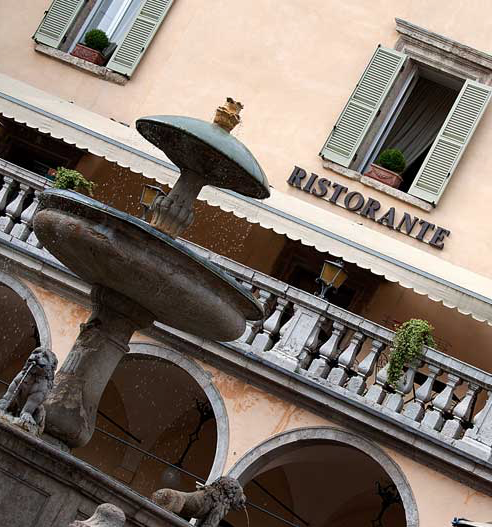Perched on a cliff along the walls of Assisi, the approach to the Basilica di San Francesco can be overpowering. Assisi is the birthplace of St. Francis, who was born Giovanni Francesco di Bernardone in 1182 and later founded the Franciscan Order and Women’s Order of Santa Clara. Thousands come to worship in Assisi's magnificent churches, and to pray to Francis of Assisi, the patron saint of Italy affectionately called Il Poverello because he lived and preached a life of simplicity and poverty. Famous for its spectacular Basilica di San Francesco, built in the 13th century, Assisi is worth visiting even without the churches, extraordinary frescoes and associations with St Francis. Founded by the Umbrians, Assisi was prominent during the Roman era but achieved its greatest fame and importance during the Middle Ages. The town still retains the architectural flavour of these times, as we enjoyed strolling through its extraordinary squares and streets.
A labyrinth of meandering Medieval walkways wind through Assisi
The Basilica di San Francesco is perhaps the most visited sight in Umbria, housing the saint’s relics and Giotto‘s renowned fresco series of St. Francis’s life
View of the Basilica
Sculpture on the front lawn of the Basilica depicting St Francis as a soldier
before he devoted himself to a life of poverty
The Basilica, which was begun in 1228, is comprised of two churches known as the Upper Church and the Lower Church, with a crypt on the lower level where the remains and relics of St Francis are interred. The Basilica and accompanying friary are a distinctive landmark when approaching the hilltop town of Assisi, one of the most important stops for Christian pilgrims visiting Italy. The Basilica's breathtaking interior and world famous frescoes, painted by the greatest artists of the time including Giotto and Cimabue, portray the life of St Francis as well as scenes from the Old and New Testament. An exquisite church with a fabulous collection of priceless frescoes, it was tragic, when in 1997, massive earthquakes hit Assisi, causing enormous damage to the Basilca and the fragile frescoes located within. Astoundingly, the restoration was done in record time, and the Basilica was reopened just two years later. Today, pilgrims flock to Assisi and the Basilica di San Francesco with the hauntingly beautiful lower church where St. Francis is buried — a simple tomb with a vaulted ceiling, painted dark blue and dotted with stars.
The interior of the Upper Church of St Francis with Giotto's fresco cycle on the life of St Francis
The Stigmata of St. Francis by Giotto, painted 1297-1300
Saint Francis' Sermon to the Birds
Miracle of the Spring
The Basilica of St Francis - The Lower Church
Side Chapel in the Basilica
The Burial Tomb of St Francis of Assisi in the Basilica
The interior Cloisters of the Church
One of the older sites within the ancient town is the former Temple of Minerva, now a Christian church, Santa Maria Sopra Minerva. The entire Roman facade, with its imposing Corinthian columns are from the first century BC. After several centuries of abandonment, 6th century Benedictine monks began to restore the space, but from the 13th to the early 16th century, the temple was even used as a city jail! In 1539, Pope Paul III ordered the inner sanctum to be completely restored. The church nave now is decorated in an extravagant Baroque style, which is unbelievably beautiful, but the contrast to the classical exterior is quite shocking.
The Roman facade of The Temple of Minerva is now a Christian Church with an extravagant Baroque interior
A pigeon waiting outside the temple for an offering perhaps
Temple of Minerva's Baroque apse
The ceiling is wildly ornate in such sharp contrast the stark Roman exterior
View over the Val d'Umbria on our stroll to the Basilica of Santa Chiara
Exterior of the Basilica di Santa Chiara, a 13th-century church that houses the relics of St. Clare,
a follower of Saint Francis of Assisi and founder of the Order of Poor Ladies,
known today as the Order of Saint Clare
The beautifully carved door and architrave
Carving detail of a lamb on the entry to Santa Chiara, the symbol for Christ
The church interior was given a Baroque makeover in 1742-57,
which was sadly destroyed by an Allied bomb in August 1943
Ornate painting of St Francis
In addition to Assisi's religious and cultural highlights, Assisi is also famous for its fine restaurants. Located in one of the most beautiful buildings in the historic centre of Assisi, with glorious views over La Piazza del Comune, is Taverna dei Consoli, which has been in business with three generations of one family since 1936. The menu emphasizes local cuisine using traditional recipes and delicious local produce, such as black truffles from Norcia, porcini mushrooms, wild boar and game plus a selection of regional cheeses. The charming interior has retained much of the original splendour of its Roman and medieval heritage with vaulted ceilings and stone arches, but on a warm summer day the best place to have lunch is on the outdoor terrace overlooking the main square.
The beautiful exterior of Taverna dei Console overlooking the fountain in Piazza del Comune
The canopy covered entrance to Taverna dei Consoli
Having reserved a table a month before, our terrace table was ready and waiting
A delightfully long and sumptuous menu on a sunny afternoon on the best terrace in Assisi
Fresh bread...
...a glass of Prosecco...
...and an Aperol Spritz - heaven!
Prosciutto Crudo di Norcia e Crostini con Paté di Fegato di Pollo
Insalate di Finocchio e Pecorino Umbro
Grilled Raddichio
Pappardelle di Ragu Rosso di Chinghiale
Umbrian Sausages with Polenta
Lamb Cutlets
Roasted Potatoes
Spinach
Macchiato









































No comments:
Post a Comment